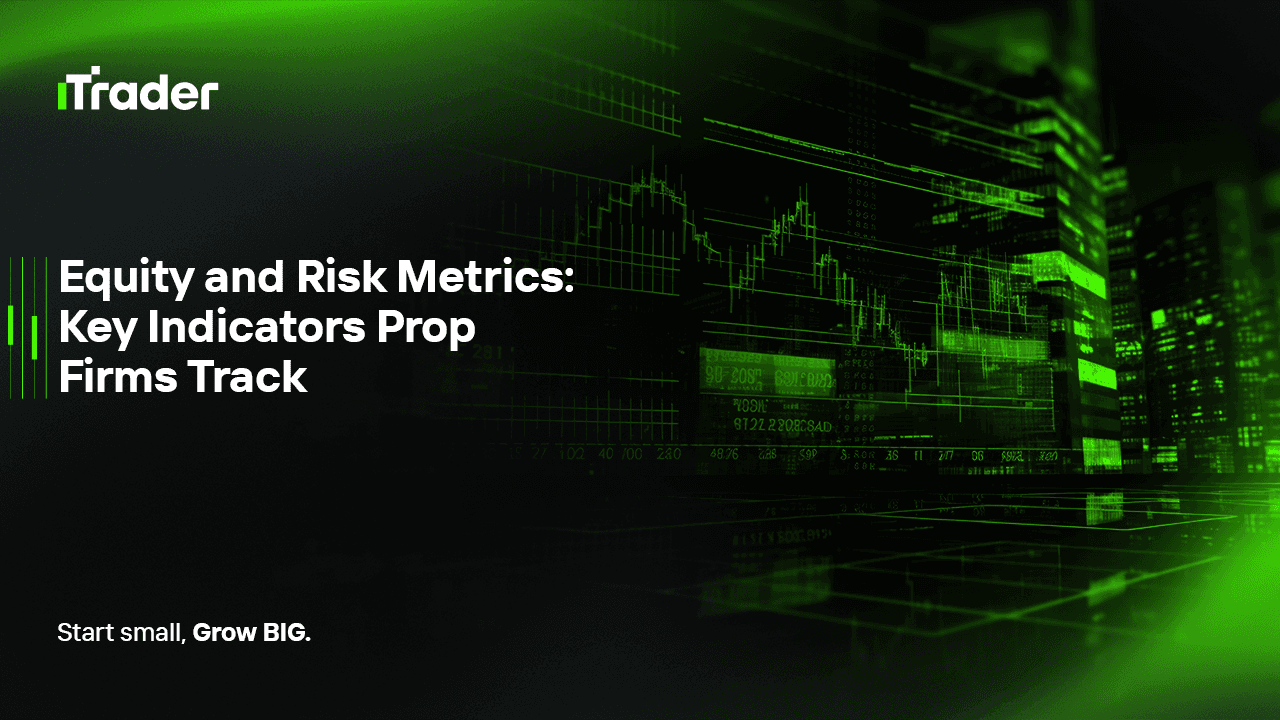2025-09-18
Every trader dreams of landing a funded account with a prop firm. The appeal is obvious: you get access to significant trading capital without risking your own money beyond the evaluation fee. But while most aspiring traders focus on how much profit they can make, prop firms are focused on something far more important: how you manage risk and equity over time.
Prop firms don’t just want traders who can hit a big profit target once. They want traders who can survive the long game. To them, it’s not about whether you can make 10% in a month — it’s about whether you can manage equity drawdowns, respect daily loss limits, and trade consistently without gambling. That’s why equity and risk metrics are at the very heart of every prop firm evaluation.

In this blog, we’ll explore the exact equity and risk metrics prop firms care about most. You’ll learn why these numbers matter, how they’re calculated, and how you can align your trading strategy with them to improve your chances of passing evaluations and keeping a funded account.
Let’s start with the basics.
Balance: This is the cash in your account excluding any open trades. If you closed all your trades right now, your balance is what you’d have.
Equity: This is your balance plus or minus any floating profit or loss from open positions.
Formula:
Equity = Balance + FloatingPnL
Example:
Equity = $10,000 + (300 – 100) = $10,200
Why prop firms care:
If your balance is $10,000 but your equity temporarily drops to $9,000 because of floating drawdown, a prop firm will count that $1,000 drop against your daily or maximum drawdown limits. In other words, equity is the true measure of risk, and it’s what firms monitor most closely.
Making money in the markets is only half the story. Without proper risk management, profits are temporary, and losses can wipe out accounts overnight. Prop firms know this, which is why their evaluations are designed to filter for traders who respect risk limits.
Risk metrics tell the firm:
These metrics don’t just matter for the evaluation stage — they’re also used once you’re funded. If you breach risk limits in a live account, your funding will be revoked, regardless of how profitable you were before.
Let’s go through the most common and important ones.
Example:
Starting balance: $100,000
Max DD limit: -$10,000
If your equity drops to $90,000 at any point, you fail the challenge.
Example:
Account: $100,000
Daily DD limit: -$5,000
If your equity drops below $95,000 on any given day — even for a second — the account is violated.
Prop firms know that one lucky trade doesn’t prove skill. That’s why they enforce rules around consistency:
Example rule: “No single trade can account for more than 30% of total profits.”
This ensures traders don’t bet big once and pray for a lucky outcome.
Example:
Passing a prop challenge isn’t just about hitting the profit target. It’s about respecting every single risk metric along the way.
Scenarios:
This is why traders who only focus on the profit target often fail challenges. Successful prop traders understand that risk metrics are the real test.
It’s worth noting that risk metrics aren’t just numbers — they’re psychological filters. Prop firms know:
By enforcing these rules, firms protect their capital and ensure only resilient, consistent traders move forward.
Equity and risk metrics form the backbone of prop firm evaluations. While many traders obsess over profit targets, the reality is that drawdowns, daily loss limits, consistency, and risk management matter far more. Prop firms aren’t searching for one-time winners — they’re searching for traders who can manage equity responsibly and perform sustainably in the long run.
If you want to succeed in prop trading, shift your mindset:
That’s the true path to not just passing evaluations, but keeping your funding and growing as a professional trader.
© 2025 iTrader Global Limited|会社登録番号:15962
iTrader Global Limitedは、コモロ連合のアンジュアン自治島ムツァムドゥのHamchakoに所在し、コモロ証券委員会によって認可・規制を受けています。ライセンス番号は L15962/ITGL です。
iTrader Global Limitedは「iTrader」の商号で運営しており、外国為替取引業務を行う許可を受けています。会社のロゴ、商標、ウェブサイトはすべて iTrader Global Limited の専有財産です。
iTrader Global Limitedの他の子会社には、iTrader Global Pty Ltd(オーストラリア会社登録番号(ACN):686 857 198)が含まれます。 この会社は、Opheleo Holdings Pty Ltd(オーストラリア金融サービスライセンス(AFSL)番号:000224485)の認可を受けた代表者(AFS代表番号:001315037)です。登録住所は Level 1, 256 Rundle St, Adelaide, SA 5000 です。
免責事項: この法人は、本ウェブサイト上で取引される金融商品の発行者ではなく、それらに対して責任を負いません。
リスク警告: 差金決済取引(CFD)は、レバレッジにより資本の急速な損失リスクが高く、すべての利用者に適しているとは限りません。
ファンド、CFD、その他の高レバレッジ商品を取引するには、専門的な知識が必要です。
調査によると、84.01%のレバレッジ取引者が損失を被っています。取引を開始する前に、リスクを十分に理解し、資金を失う可能性があることを認識してください。
iTraderは、レバレッジ取引によるリスク、損失、またはその他の損害について、個人または法人に対して一切の責任を負わないことを明言します。
利用制限: iTraderは、法律、規制、または政策によりこのような活動が禁止されている国の居住者を対象として、本ウェブサイトやサービスを提供していません。